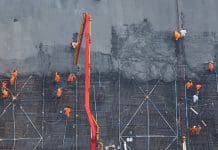Premier Guarantee’s technical team provides practical advice for building masonry walls and how to avoid cracking
Building with masonry has been around for centuries with historic structures still standing today such as the Egyptian pyramids and Roman amphitheatres. It is no surprise masonry walls are still the most popular building structures used with benefits such as durability, strength, temperature control, fire protection, noise barrier, ‘green’ material and a large range of aesthetics. However, movement in these types of walls are common, and provisions must be incorporated into the design to avoid the structure being compromised and unwanted cracking appearing.
Causes of movement
After construction, buildings are subject to small dimensional changes, which can be caused by one or more of the following factors:
1) Change in temperature
2) Change in moisture content
3) Absorption of water vapour
4) Chemical action, e.g. carbonation
5) Deflection under loads
6) Ground movement and differential settlement.
Masonry is not completely free to expand or contract because restraints are often present, and so compressive or tensile forces can develop and these can lead to bowing or cracking.
Movement characteristics of masonry units made of clay, calcium silicate, concrete and stone, are likely to vary within each material type, due to differences in raw materials and/or manufacture, but movement characteristics differ more significantly between units of different types of material.
All materials expand and contract in response to thermal changes. Also, clay materials undergo an irreversible expansion after their manufacture as moisture is absorbed from the atmosphere. Other masonry materials shrink following manufacture to reach the equilibrium state.
Units made from different types of material should not be bonded together in masonry in a manner that would cause stress to develop as a result of dissimilar characteristic movement. Where anticipated movements are different in magnitude and nature, parts of masonry of different material type should be effectively separated, e.g. by vertical or horizontal movement joints and/or slip planes. Alternatively, they should be suitably reinforced.
Generally, changes in temperature, moisture content or rate of drying out due to the presence of insulation, do not need to be taken into account when considering movement in masonry. However, for brick masonry of certain clay bricks in applications where restraint is low (e.g. cladding) and high levels of solar heating are anticipated because of orientation, reduced spacing between movement joints is beneficial.
Accommodation for movement in masonry:
i) Movement joints should be provided in the masonry to accommodate its expansion and/or contraction due to changes in temperature and the moisture characteristics of the masonry units. Joints should be built-in as work proceeds.
ii) Slip planes should be designed to allow parts of the construction to slide, one in relation to the other, thus reducing shear stresses in the adjacent materials. The design and positioning of movement joints and slip planes should be carefully considered, to ensure that in addition to accommodating movements, such joints or planes do not impair the stability of the wall or any of its functions.
iii) In external walls, movement joints and slip planes should be sealed, protected or otherwise designed to prevent water penetration.
vi) Fixings and services should not interfere with the performance of the joints or slip planes. Finishes should be discontinuous at movement joints and slip planes. Fixings and fittings should not tie across joints.
Recommendations – provision of movement joints
The position of movement joints should take into account the need to maintain the structural integrity of the wall.
Unrestrained or lightly restrained unreinforced walls generally expand 1mm/m during the life of a building, due to thermal and moisture movement changes. The spacing and width of movement joints to control expansion in such walls is governed by the compressibility of fillers and the performance of appropriate sealants.
As a general guide, the width of the joint in millimetres should be about 30% more than the numerical value of the distance between joints in metres. For example, movement joints at 12m centres should be a minimum of 15mm wide.
The expansion of normal storey height walls, as opposed to unrestrained walls, is somewhat less than 1mm/m during the life of a building, and that expansion often reduces with increasing restraint. However, to avoid cracking due to thermal contraction, the spacing between movement joints should never exceed 15m in unreinforced walls.
Where clay bricks made from different types of clay are built in the same wall to produce decorative effects, e.g. contrasting bands of colour, differences in their movement characteristics can dictate that more frequent spacing of movement joints is required. The brick manufacturers should be consulted.
If a return in the length of clay masonry is less than 675mm and either adjoining length of masonry exceed 6m, the masonry should be interrupted at the return to prevent the development of a mechanical couple and a risk of cracking. This can be affected by the introduction of a vertical, compressible joint or a “slide-by” detail. Returns of 675 mm or more should be regarded as having sufficient inherent flexibility to accommodate the stress caused by the opposing forces.
Calcium silicate masonry should be designed as a series of panels separated by movement joints to control contraction. The ratio of length to height of the panels should generally not exceed 3:1. As a rule, vertical joints to accommodate horizontal movement should be provided at intervals of between 7.5m and 9m. Movement joints need not generally exceed 10mm in width. They should be sealed where necessary.
Concrete masonry should be designed as a series of panels separated by movement joints to control contraction. The degree of movement is dependent upon the unit type and, as a rule; vertical joints to accommodate horizontal movement should be provided at intervals of 6m. The ratio of length to height of the panels should generally not exceed 3:1.
For calcium silicate and concrete masonry in external walls containing openings, movement joints may be needed at more frequent intervals or the masonry above and below the opening may need to be reinforced to restrain movement. Particular attention should be paid to long low horizontal panels of masonry, e.g. those under windows. External walls of concrete masonry should have a compressible joint to allow for thermal expansion at not more than 30 m intervals.
Following these provisions will mean your wall will reach its optimum structural performance and should stand the test of time.
For more information and further technical advice, please visit our website and download our technical manual: http://www.premierguarantee.co.uk/
Premier Guarantee
+44 (0) 8444 120 888
Twitter @PG_Live
Please note: this is a commercial profile













